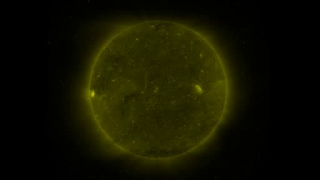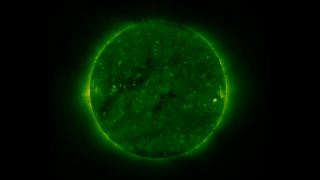STEREO in Stereo
Overview
A collection of media related to the STEREO mission which are configured for display by various stereo technologies.
STEREO "First Light" Movies
These movies were released as part of the STEREO "First Light" Press Conference on April 23, 2007. STEREO's Extreme Ultraviolet Imaging Telescope captured these images of the sun March 17-27, 2007. STEREO can see the sun in several different wavelengths. Each wavelength allows scientists to view different temperatures and features on the sun.
First 3-D Stereo from STEREO: EUVI 171 Angstroms (Full Disk View)
Go to this pageThis movie shows the Sun from the two STEREO spacecraft using the 171 ||
First 3-D Stereo from STEREO: EUVI 171 Angstroms (South Pole View)
Go to this pageThis movie shows the south pole of the Sun from the two STEREO spacecraft using the 171 angstrom filter in the Extreme UltraViolet Imager (EUVI). This filter reveals ionized iron (Fe+8=Fe IX, Fe+9=Fe X) which forms at temperatures above 1.3x106K, and flows along the magnetic field lines of the solar active regions. New active regions come into view as the Sun rotates. ||
First 3-D Stereo from STEREO: EUVI 284 Angstroms (Full Disk View)
Go to this pageThis movie shows the Sun from the two STEREO spacecraft using the 284 angstrom filter in the Extreme UltraViolet Imager (EUVI). This filter reveals ionized iron (Fe+14=Fe XV), which forms at temperatures above 2x106K, and flows along the magnetic field lines of the solar active regions. New active regions come into view as the Sun rotates. ||
First 3-D Stereo from STEREO: 284 Angstroms (Active Region)
Go to this pageThis movie shows the Sun from the two STEREO spacecraft using the 284 angstrom filter in the Extreme UltraViolet Imager (EUVI). This filter reveals ionized iron (Fe+14=Fe XV), which forms at temperatures above 2x106K, and flows along the magnetic field lines of the solar active regions. New regions come into view as the Sun rotates. ||
First 3-D stereo from STEREO: EUVI 304
Go to this pageThis movie shows the Sun from the two STEREO spacecraft using the 304 ||
First 3-D Stereo from STEREO: 304 Angstroms (South Pole View)
Go to this pageThis movie shows the Sun from the two STEREO spacecraft using the 304 ||
First 3-D Stereo from STEREO: EUVI 195 Angstroms (Full Disk View)
Go to this pageThis movie shows the Sun from the two STEREO spacecraft using the 195 ||
First 3-D stereo from STEREO: EUVI 171 Ångströms (Active Region)
Go to this pageThis movie shows the Sun from the two STEREO spacecraft using the 171 ? filter in the Extreme UltraViolet Imager (EUVI). This filter reveals ionized iron (Fe+8=Fe IX, Fe+9=Fe X) which forms at temperatures above 1.3x106K, and flows along the magnetic field lines of the solar active regions. New regions of solar activity come into view as the Sun rotates left to right. ||
Post "First Light"
STEREO in Stereo: April 8, 2007
Go to this pageFull Disk View: Image sequences taken April 8-9, 2007 by the EUVI telescopes on the two STEREO spacecraft (STEREO-B, left eye; STEREO-A, right eye). At this time the spacecraft were about 3.7 degrees apart. These images show the Sun in extreme ultraviolet light at a wavelength of 171 angstroms, highlighting parts of the Sun's atmosphere (the corona) at about one million degrees C. Note the bright active regions near the Sun's equator and the dark "coronal holes" at the north and south poles. These are features of the Sun's magnetic field. Coronal holes are areas where the magnetic field opens out to allow material to flow out into the solar system, while active regions are made up of strong, closed fields which bottle up hot plasma (ionized gas) close to the surface. This image was taken near the minimum in solar activity, so there are few active regions.Closeup View: Image sequences taken April 8-9, 2007 by the EUVI telescopes in the SECCHI imaging suites on the two STEREO spacecraft (STEREO-B, left eye; STEREO-A, right eye). At this time the spacecraft were about 3.7 degrees apart. Here we see a close up of solar magnetic active regions, flickering as they rotate out of sight around the sun. These are areas where the Sun's strong magnetic field bottles up million degree C plasma (ionized gas) low in the corona (the Sun's outer atmosphere). These images are taken at a wavelength of 171 angstroms (0.00000171 cm) in the extreme ultraviolet.Note for Large Displays: These movies are produced using images from STEREO where the angle between the spacecraft is getting larger than the optimum angle for stereo separation. While they work well on small displays, large-screens and projection systems can introduce significant distortions in the stereo effect which the audience may find uncomfortable. When doing large-screen projection, you may need to adjust the left-right image alignment for optimum viewing. However, this does not guarantee a distortion-free result. ||
Supporting Media
Grand Tour of the Coronal Loops Model
Go to this pageThis is a longer coronal loops tour combining components of the two previous versions (Animation IDs 3286 and 3287). The solar model is constructed from magnetogram data collected by SOHO/MDI. Because we do not see the full solar surface at any one time, the magnetograms collected over the course of a solar rotation are processed through a time-evolving solar surface model which provides a snapshot of the surface at a fixed time. The resulting magnetogram is then processed through the Potential Field Source Surface (PFSS) model which constructs the magnetic field above the solar surface. The magnetic field around the Sun is then analyzed for field lines, which creates the loop structures we see in the model. Hot plasma tends to flow along the magnetic field lines, creating the coronal loops. These loops are only visible at the higher temperatures corresponding to ultraviolet light, in this case, 195 angstroms, one of the filter wavelengths of SOHO/EIT. For this version, we color the coronal loops green for ready comparison to the EIT 195 angstrom imagery using the EIT standard color table. ||
Flight through the Coronal Loops
Go to this pageHere we illustrate the potential benefits of the 3-D views of the Sun which STEREO will provide. Starting with a simple 2-D EIT ultraviolet image from SOHO, we transition to a 3-D model and move through the coronal loops which are constructed along solar magnetic fields. The solar model is constructed from magnetogram data collected by SOHO/MDI. Because we do not see the full solar surface at any one time, the magnetograms collected over the course of a solar rotation are processed through a time-evolving solar surface model to provide a snapshot of the surface at a fixed time. The resulting magnetogram is then processed through the Potential Field Source Surface (PFSS) model. Coronal loops are visible at the higher temperatures of ultraviolet light, in this case, 195 angstroms, the filter wavelength of SOHO/EIT. For this version, we color the coronal loops green for ready comparison to the EIT 195 angstrom imagery using the EIT 'standard color table'. ||
Rotating Tour of Solar Coronal Loops
Go to this pageA slow rotating tour of a data-based coronal loop model. This version is designed for continuous loop play. The solar model is constructed from magnetogram data collected by SOHO/MDI. Because we do not see the full solar surface at any one time, the magnetograms collected over the course of a solar rotation are processed through a time-evolving solar surface model to provide a snapshot of the surface at a fixed time. The resulting magnetogram is then processed through the Potential Field Source Surface (PFSS) model. Coronal loops are visible at the higher temperatures of ultraviolet light, in this case, 195 angstroms, the filter wavelength of SOHO/EIT. ||
STEREO Fly-by
Go to this pageThis animation shows a stereoscopic 3D fly-by of STEREO A spacecraft. || This animation shows a stereoscopic 3D fly-by of STEREO A spacecraft. || STEREO.069000652_print.jpg (1024x576) [54.0 KB] || STEREO.0690_web.png (320x180) [241.3 KB] || Stereo.webmhd.webm (960x540) [5.7 MB] || Stereo.mov (720x405) [54.2 MB] ||
Tour of the Magnetsphere in 3D
Go to this pageThis animation shows the Earth's magnetosphere based on a magnetosphere model from the Community Coordinated Modeling Center at GSFC. || 3-D Anaglyph || SELeft.030000152_print.jpg (1024x576) [60.4 KB] || SELeft.0300_web.png (320x180) [83.5 KB] || SELeft.0300_thm.png (80x40) [5.5 KB] || MagnetosphereAng.webmhd.webm (960x540) [9.0 MB] || MagnetosphereAng.mp4 (720x405) [153.3 MB] || MagnetosphereAng.mov (720x405) [180.2 MB] ||













